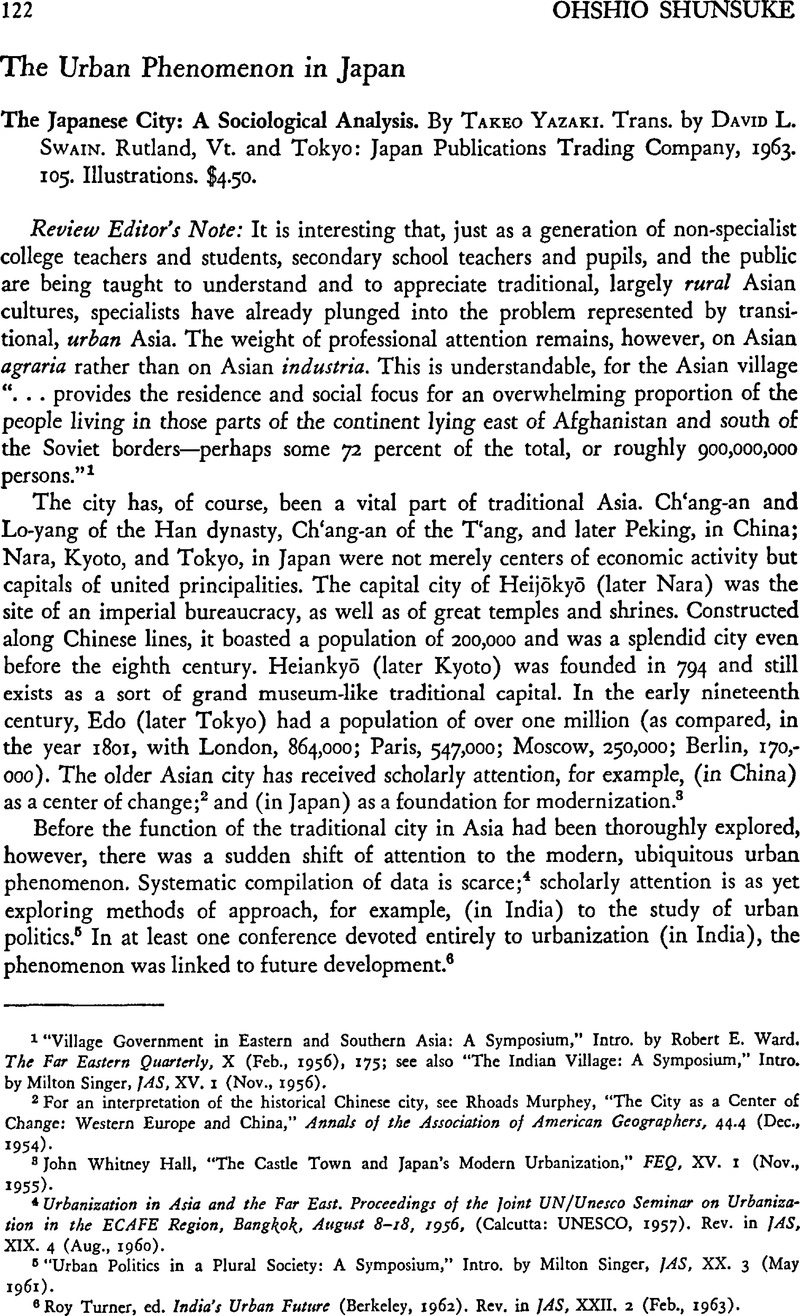No CrossRef data available.
Article contents
The Urban Phenomenon in Japan
Review products
Published online by Cambridge University Press: 23 March 2011
Abstract

- Type
- Review Articles
- Information
- Copyright
- Copyright © The Association for Asian Studies, Inc. 1964
References
1 “Village Government in Eastern and Southern Asia: A Symposium,” Intro, by Ward, Robert E.. The Far Eastern Quarterly, X (Feb., 1956), 175CrossRefGoogle Scholar; see also “The Indian Village: A Symposium,” Intro- by Singer, Milton, JAS, XV. 1 (Nov., 1956)Google Scholar.
2 For an interpretation of the historical Chinese city, see Murphey, Rhoads, “The City as a Center of Change: Western Europe and China,” Annals of the Association of American Geographers, 44.4 (Dec, 1954)CrossRefGoogle Scholar.
3 Hall, John Whitney, “The Castle Town and Japan's Modern Urbanization,” FEQ, XV. 1 (Nov., 1955)Google Scholar.
4 Urbanization in Asia and the Far East. Proceedings of the Joint UN/Unesco Seminar on Urbanization in the ECAFE Region, Bangkok., August 8–18, 1556, (Calcutta: UNESCO, 1957). Rev. in JAS, XIX. 4 (Aug., 1960).
5 “Urban Politics in a Plural Society: A Symposium,” Intro, by Singer, Milton, JAS, XX. 3 (May 1961)Google Scholar.
6 Turner, Roy, ed. India's Urban Future (Berkeley, 1962)Google Scholar. Rev. in JAS, XXII. 2 (Feb., 1963).
7 “City and Village in Japan,” ed. by Smith, Thomas C., Economic Development and Cultural Change, IX. I, Part II (Oct., 1960)Google Scholar.
8 Dore, R. P., City Life in Japan; A Study of a Tokyo Ward (Berkeley, 1958)CrossRefGoogle Scholar. Rev. in JAS, XVII. 4 (Aug. 1959).
9 Nouët, Noĕl, Histoire de Tokyo. Publications de la Maison Franco-Japonaise (Paris, 1961)Google Scholar. Rev. in ]AS, XXI. 3 (May, 1962).
10 Burks, Ardath W., “Japan: 'The Kitchen and the Garden,'” Current History, 46.272 (Apr., 1964)Google Scholar.
11 Vogel, Ezra F., Japan's New Middle Class; The Salary Man and His Family in a Tokyo Suburb (Berkeley, 1963)Google Scholar.
12 Kyogoku, Jun-ichi and Ike, Nobutaka, “Urban-Rural Differences in Voting Behavior in Postwar Japan,” Stanford University Political Science Series, 66 (1960)Google Scholar.
13 Plath, David W., The After Hours; Modern Japan and the Search for Enjoyment (Berkeley, 1964)Google Scholar.
14 Takeo, Yazaki, Nihon toshi no hatten katei [The Process of Development of the Japanese City] (Tokyo: Kobundo, 1962)Google Scholar.
15 Particularly The Folk. Culture of Yucatan (Chicago, 1941)Google Scholar; and “The Folk Society,” American Journal of Sociology, 52.4 (Jan., 1947)Google Scholar.
16 Sjoberg, Gideon, “The Pre-industrial City,” The American Journal of Sociology, LX.5 (Mar., 1955)Google Scholar.
17 Lewis, O., “Urbanization Without Breakdown,” Scientific Monthly, July, 1952.Google Scholar
18 Whyte, W. H. Jr., The Organization Man (New York, 1956)Google Scholar.
19 Eitarō, Suzuki, Toshi shafaigal(u genri [Principles of Urban Sociology] (Tōkyō: Yūhikaku, 1957)Google Scholar.
20 Sjoberg, G., “Comparative Urban Sociology,” in Merton, R. K., ed. Sociology Today (New York, 1959)Google Scholar.
21 Shigenkyoku, Kagaku Gijutsu-chō, Kokuren, Chōsadan oboegaki [United Nations Investigation Mission Memorandum.] (Tōkyō: 1963.Google Scholar)
22 Fukutarō, Okui, Gendai daitoshi ron [Theory of the Modern Metropolis] (Tōkyō: Yūhikaku, 1941)Google Scholar.
23 Eiichi, Isomura, Toshishakaigaku kenhyū [Research in Urban Sociology] Tōkyō: Yūhikaku, 1959)Google Scholar; Suzuki, J., Toshi to sonraku no shakaigakuteki kenkuû [Sociological Research on City and Village] (Tōkyō: Sckaishoin, 1956)Google Scholar; Yasuda, S. “Toshishakai to tokaijin” (“City Society and Urban People”) in Eiichi, Isomura, ed. Toshi [City] (Tōkyō: Yūhikaku, 1954)Google Scholar; Kurasawa, S. “Toshishakai no kōzō” (“The Structure of City Society”) in Fukutake, T. ed. Kōza shakjiigaku [Lectures on Sociology], IV (Tōkyō: Tōkyō Daigaku Shuppan Kai, 1957)Google Scholar; Suzuki, H. “Toshikenkyū ni okeru chū-hani riron no kokoromi” (“A Test of the Theoretical Scope and Method in Metropolitan Research”), Shakaigaku Hyōron, 9.3 (1959)Google Scholar; Kuratsuji, H., Toshi no keizai shakai riron [Socio-Economic Theory of the City] (Tōkyō: Minerva Shobō, 1959)Google ScholarTetsuo, Ōmi, “Toshishakaigaku no genjō to kadai” (“Themes in, and the State of Urban Sociology”). Takeda, R., ed. Konnichi no shakaigaku [Today's Sociology] (Tōkyō. Yūshindū, 1960)Google Scholar.
24 Tokue, Shibata, Tōkyō; sono keizai to shakai [Tōkyō; its economy and society] (Tōkyō: Iwanami Shoten, 1959)Google Scholar; see also his Sekai no toshi wo megutte [Looking at many cities of the world] (Tōkyō: Iwanami Shoten, 1964)Google Scholar. Professors Isomura, Shibata, and the author of this review-article are all affiliated with Tokyo Metropolitan University, which has an institutional arrangement with Rutgers in the field of urban studies.
25 In addition to sjoberg, see Smith, Robert J., “Pre-industrial Urbanism in Japan: A Consideration of Multiple Traditions in a Feudal Society,” Economic Development and Cultural Change, IX.I, Part II (Oct., 1960)Google Scholar.


